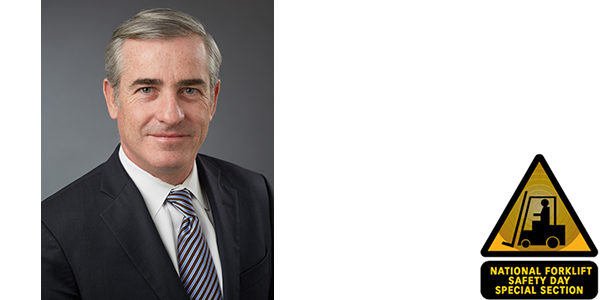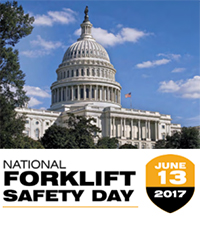Spreading the word on forklift safety


The forklift industry will be in Washington, D.C., again this spring as members of the Industrial Truck Association (ITA) take part in the organization's fourth annual National Forklift Safety Day. This event, scheduled for June 13 in the nation's capital and across the country, will provide an opportunity for the industry to educate customers, the public, and government officials about the safe use of forklifts and the importance of proper operator training.
Safety is one of Washington, D.C.-based ITA's biggest priorities. The organization, which represents manufacturers of lift trucks, tow tractors, pallet trucks, and automated guided vehicles in North America, promotes international standards for product safety, advances engineering and safety practices, and partners with the Occupational Safety and Health Administration (OSHA) and other safety-focused organizations.
ITA says it hopes National Forklift Safety Day will provide greater awareness of safe practices as well as encourage safer behavior in warehouses, distribution centers, and manufacturing plants. To learn more about the event, we spoke with ITA President Brian Feehan. A longtime industry association executive, he previously worked in the U.S. and Europe for organizations promoting the safe use of liquefied petroleum gas (LPG, usually referred to as propane) for vehicles and other applications. Here's what he had to say.
Q: Tell us about the Industrial Truck Association—what is its mission, and how does the organization's work benefit end users of lift trucks?
A: ITA communicates and collaborates with its members, global industry associations, and a wide range of stakeholders to develop effective programs, resources, and leadership. There are many ways we accomplish this. For example, we are an influential industry voice for standards development and free and fair trade, and we collect and disseminate statistical marketplace information. In regard to safety, ITA advances engineering practices throughout the industry to promote safe products and partners with OSHA to train compliance officers, distribute workplace safety materials, and exchange safety information.
I mentioned statistical information and would like to expand on that. ITA's market intelligence depicts industry trends, helping businesses to recognize the changing needs of the industrial truck industry and get the information, news, and insight they need to support decision-making. The statistical information we provide includes quarterly market estimates, quarterly economic reports, a business trends survey, and world industrial truck statistics.
We've added something new this year that I think your readers will find very interesting. The association recently launched a research initiative to quantify the economic impact we have in the United States. The world-renowned [business consulting firm] Oxford Economics is conducting the study, and we will issue the final report, called "Lifting America: The Economic Impact of Industrial Truck Manufacturers, Distributors, and Dealers," very soon. We're excited about the report and have received some impressive preliminary numbers. For instance, the lift truck industry contributes over $25 billion to U.S. GDP annually, pays over $5 billion in taxes annually, and employs more than 200,000 people. The study also revealed that for every one job in our industry, we create an additional 2.5 jobs.
Q: What is the purpose of National Forklift Safety Day, and has it changed since the program was first launched?
A: National Forklift Safety Day serves as a focal point for manufacturers to highlight the safe use of forklifts and the importance of operator training. It provides an opportunity for the industry to educate customers, the public, and government officials about safe forklift operation.
The program is now in its fourth year, and we're staying focused on reinforcing its message that operator training is a critical component to ensuring safety. Over the past few years, ITA has created additional materials for members to use in local and national events to support National Forklift Safety Day.
Q: What kind of activities do you have planned for National Forklift Safety Day in Washington?
A: We have a busy schedule of activities that will span two days. On Monday, June 12, from 3 to 5 p.m. there will be an educational session that's open to all ITA members and invited guests. Topics will include an update on OSHA policies and ITA's collaboration with the agency, as well as an update on current congressional activity that could affect our members. We'll follow that with a networking reception for attendees. Tuesday morning, June 13—National Forklift Safety Day itself—will feature speakers from industry and government, including elected officials. In the afternoon, members will visit their congressional representatives to convey our message about the critical importance of workplace safety and discuss how elected officials can help to support that.
Q: How will ITA members be recognizing National Forklift Safety Day at the local level?
A: In addition to the Washington, D.C., program, many ITA members further support National Forklift Safety Day by sponsoring events in their communities across the country. Some examples include offering free operator training, distributing safety material, and hosting open houses for current and prospective customers as well as the general public and local officials.
Q: What's the main message ITA would like DC Velocity's readers to take away from National Forklift Safety Day?
A: Thanks to the support of our members, DC Velocity and other industry publications, and our sister associations in the industry, we were able to reach a large audience—more than 60 million people—with our message last year. We plan to do the same this year.
That message is that operator training is a critical component of ensuring safety in the workplace. OSHA's powered industrial truck regulation, which ITA was instrumental in developing nearly 20 years ago, specifies a robust training program that is very effective when employers take it seriously and meet its requirements. It includes classroom training, hands-on instruction, and practical evaluation of the trainee. If there is a theme to the OSHA regulatory requirements, it's that training must be tailored to both the particular work environment and the particular type of equipment the operator will encounter on the job. That means that generic or general training, such as merely watching a video, falls far short of what's required. Unfortunately, one of the most frequently cited OSHA violations involving forklifts is a failure to train the operator adequately. We hope that National Forklift Safety Day will help to improve that compliance picture, because better training and safer operation will benefit every stakeholder, but especially forklift operators and their families.
Let me just finish up by mentioning that National Forklift Safety Day activities in Washington are free and open to anyone interested in attending. Your readers can visit the ITA website at www.indtrk.org/events for hotel information and updates on the program, and to register for the event.
Other articles about National Forklift Safety Day 2017:
Related Articles
Copyright ©2024. All Rights ReservedDesign, CMS, Hosting & Web Development :: ePublishing